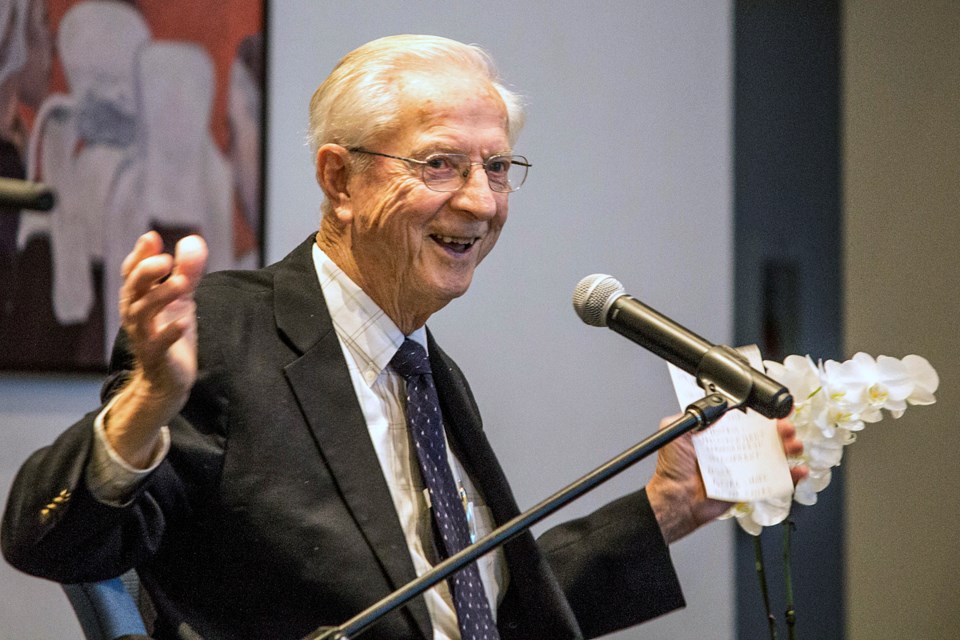Bishop Remi De Roo was in Rome and managed to catch the attention of Pope Francis as the pontiff’s entourage passed by. De Roo, the retired Roman Catholic bishop for Victoria, told the pontiff that he was a “Council father,” one of the few surviving bishops who attended the landmark Second Vatican Council in the early 1960s.
Pope Francis stopped his procession, moved toward De Roo and, in a gesture seemingly the reverse of the natural order, the Pope kissed the ring De Roo was wearing. The ring, which De Roo passed around a group of people who came to see him speak at UBC this month, was a gift from one of the Pope’s predecessors to De Roo and the other bishops who participated in Vatican II, as the council is commonly called.
The Second Vatican Council was the defining event in De Roo’s life. He was a young priest in Manitoba when, in 1962, he was appointed bishop of Victoria. Immediately, De Roo was called to Rome. The Vatican Council had already begun and all the bishops, as well as other church leaders and, notably, religious figures from non-Roman Catholic rites, as well as other faith groups, were also invited guests. Nobody was entirely certain what the council would accomplish, but there was a sense of enormous import as it got underway.
Originally intended as a lengthy but one-off convention of Catholic hierarchy, it expanded over four years, with bishops from around the globe reconvening every autumn until 1965.
While such conferences had taken place at times in history, they were usually devoted to a single doctrinal or theological question. This Second Vatican Council was convened for the vague but vast purpose of addressing the relation of the church itself to the modern world.
“In the time of astronauts,” De Roo told me, “we were very conscious of importance of critical direction and making the adjustments necessary.”
Among the most significant changes that emerged from Vatican II was the use of vernacular languages in the mass. Until then, services had taken place in Latin, a language fewer and fewer Catholics understood.
“Faith comes from hearing, as the scriptures say,” says De Roo. “If you don’t understand what is being said, you cannot make the appropriate response in faith. Because this council was a pastoral council, it was profoundly concerned with the spiritual needs of the people... As a result, we had to allow an opportunity for people to speak in their own languages, in their own tongues, in language that would be meaningful to their own cultures, so that the faith would be better understood and more faithfully followed.”
The council resulted in a vast range of changes that are generally perceived as liberalizations. In addition to the replacement of Latin with local languages, priests began to face the congregation during mass, rather than having their backs to parishioners. It was also a time of opening up relations with other faith groups, including Protestants and, notably, redefining official Catholic teaching on the Jewish people and Judaism. After the council, strict dress codes for nuns relaxed and, more substantively, priests and nuns became more involved in social issues. For his part, De Roo became a powerful voice for the Liberation Theology movement, a Latin American-based religious stream that rebelled against the oppression of the region’s dictators. He was also a voice for the disadvantaged closer to home and Dave Barrett, the province’s first New Democrat premier, named De Roo head of the new B.C. Human Rights Commission.
De Roo was called to the carpet (well, to the Vatican office of Archbishop Joseph Ratzinger, enforcer of church doctrine and later Pope Benedict XVI) and dressed De Roo down for remarks he had made sympathetic to the idea of ordaining women to the priesthood. (De Roo did not court controversy, but his reputation was tarnished by ill-advised investments of diocesan funds during his time as bishop, leading to a financial crisis for which he delivered a profound apology.)
Often referred to as a radical bishop, De Roo responds to the moniker with a bit of etymology.
“I’ll accept that term radical if it means going to the roots of our faith, which is what radical means,” he says. “I like to get down to the heart of issues and not just be at the superficial level.”
De Roo left his post as bishop in 1999 at the mandatory retirement age of 75, at which point he was Canada’s longest-serving Catholic bishop, but continues, at 92, to evangelize about the values and changes ushered in by the council. He calls himself a “pilgrim of the Second Vatican Council.”
Reflecting on the day the current Pope kissed his ring, De Roo believes Francis’ demonstrativeness was a sign of the current Pope’s attitude toward the significance and relevance of Vatican II. While De Roo does not say so, there is a widely held perception that the liberalizations of the Second Vatican Council were not as admired by some of Francis’ predecessors, conservative pontiffs like Benedict XVI or John Paul II.
As for his own association with causes that have created ripples among the Catholic hierarchy, De Roo has no apologies.
“There is nothing wrong with controversy,” he says. “We need controversy. We should have even more controversy. But it has to be controversy around basic issues and it’s got to be done in a spirit of charity and with a commitment to seeking the truth, not just making points or scoring ideological interventions or orientations.”
@Pat604Johnson



